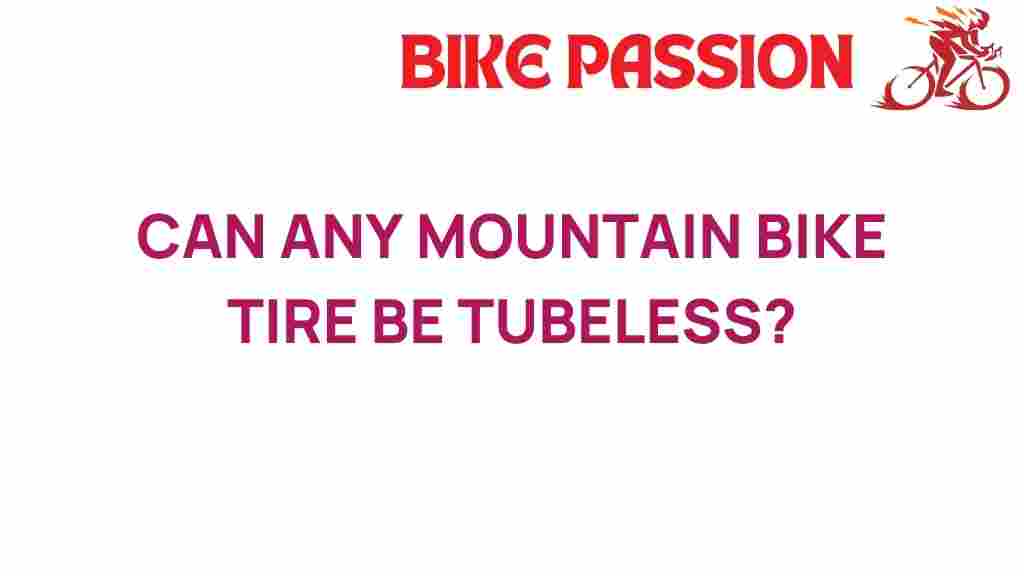Unlocking the Secrets: Can Any Mountain Bike Tire Go Tubeless?
Mountain biking is one of the most exhilarating ways to explore the great outdoors, combining adventure with fitness. A crucial aspect of enhancing your mountain biking experience is the choice of tires. One popular trend among mountain bikers is converting to tubeless tires. But can any mountain bike tire go tubeless? In this article, we will explore the compatibility of tubeless tires, the benefits they offer, and how to ensure your bike is set up for the best performance. Whether you’re an experienced cyclist or a newcomer, understanding tire technology is essential for bike maintenance and off-road biking success.
Understanding Tubeless Tires
Tubeless tires are designed to eliminate the inner tube, creating a more efficient and reliable system. This innovation offers several advantages:
- Reduced Weight: Without the inner tube, tubeless setups are often lighter, which can improve bike performance.
- Lower Tire Pressure: Tubeless tires can run at lower pressures, enhancing grip and comfort on rough terrains.
- Puncture Resistance: The sealant inside the tire can quickly seal small punctures, allowing you to keep riding without stopping.
- Better Traction: Tubeless tires conform better to the ground, providing improved traction on off-road trails.
Tire Compatibility: Can Any Mountain Bike Tire Go Tubeless?
One of the most common questions among mountain bikers is whether any mountain bike tire can be converted to a tubeless setup. The answer is not straightforward. Here are some factors to consider:
- Tire Design: Not all mountain bike tires are designed to be tubeless-compatible. Look for tires labeled as “tubeless-ready” or “tubeless-compatible.” These tires typically have a bead that can create an airtight seal with the rim.
- Rim Compatibility: Your bike’s rims must also support tubeless tires. Rims designed for tubeless setups often have a specific shape and require a proper sealant to prevent air loss.
- Sealant Usage: Tubeless tires require sealant to function effectively. This sealant helps fill any gaps between the tire and rim and seals punctures as they occur.
Step-by-Step Process to Convert Your Mountain Bike to Tubeless
If your tires and rims are compatible, follow this step-by-step process to convert your mountain bike to a tubeless system:
1. Gather Your Supplies
Before you start, make sure you have the following materials:
- Tubeless-ready tires
- Tubeless-compatible rims
- Tire sealant
- Tire levers
- Air compressor or high-volume pump
- Valves (if not included with the rims)
2. Prepare the Rims
Ensure your rims are clean and free from any dirt or debris. If you’re converting from traditional tires, remove the inner tubes and clean the rim tape. Install tubeless rim tape if your rims are not already tubeless-ready.
3. Install the Tubeless Valves
Insert the tubeless valves into the rim holes, ensuring they are properly sealed. Tighten them as per the manufacturer’s instructions.
4. Mount the Tubeless Tires
Carefully mount one side of the tire onto the rim. Then, add the tubeless sealant to the tire before completing the installation of the second side. This prevents sealant from spilling during the installation.
5. Inflate the Tire
Using an air compressor or high-volume pump, inflate the tire quickly to help the bead seat properly against the rim. You may need to shake the tire to move the sealant around and create a good seal.
6. Check for Leaks
After inflating, inspect the tire for any signs of air leakage. If you notice any, try to reseat the tire or add more sealant as necessary.
Troubleshooting Common Tubeless Tire Issues
Even with proper installation, you may encounter issues with your tubeless tires. Here are some common problems and how to resolve them:
1. Tire Not Seating Properly
If the tire bead isn’t seating properly, try the following:
- Inflate the tire quickly to create a sudden burst of air pressure.
- Ensure the rim and tire are clean and free of obstructions.
- Check if the valve is properly installed and not obstructing the bead.
2. Loss of Air Pressure
If you notice a drop in air pressure, consider the following:
- Inspect for punctures or leaks in the tire.
- Check the valve core to ensure it’s tight.
- Reapply sealant as it may dry out over time.
3. Sealant Clogging
Occasionally, sealant can dry and clog the valve. To fix this:
- Remove the valve core and flush it with water.
- Reinstall the valve and ensure it’s functioning properly.
Maintaining Your Tubeless Setup
To ensure your tubeless tires perform at their best, regular maintenance is essential. Here are some tips:
- Check Tire Pressure: Regularly check and maintain the recommended tire pressure for optimal performance.
- Inspect Sealant Levels: After every few rides, check the sealant levels and replenish as necessary.
- Clean the Tires: Keep your tires clean from mud and debris to prevent damage and ensure longevity.
Benefits of Tubeless Tires for Off-Road Biking
Switching to tubeless tires can significantly enhance your off-road biking experience. The advantages include:
- Improved Grip: Lower pressure allows for a larger contact patch, improving grip on uneven surfaces.
- Fewer Flat Tires: The ability to seal punctures helps keep you on the trail longer, reducing interruptions.
- Enhanced Comfort: Riding at lower pressures absorbs more shock from trails, making for a more comfortable ride.
Conclusion
In conclusion, while not all mountain bike tires can go tubeless, many modern options are designed for this purpose. Understanding tire compatibility, proper installation, and maintenance is key to unlocking the full benefits of tubeless tires. With the right setup, you can enhance your cycling experience, improve bike performance, and enjoy the thrills of off-road biking without the hassle of frequent flat tires. For more information on cycling gear and bike maintenance, check out our detailed guide on cycling essentials. For technical specifications on tire technology, visit tire technology insights.
This article is in the category Gear and created by BikePassion Team
